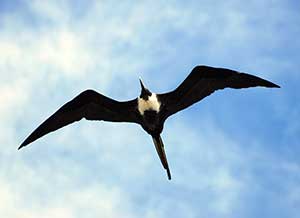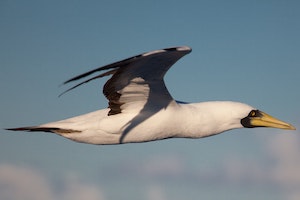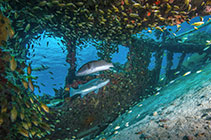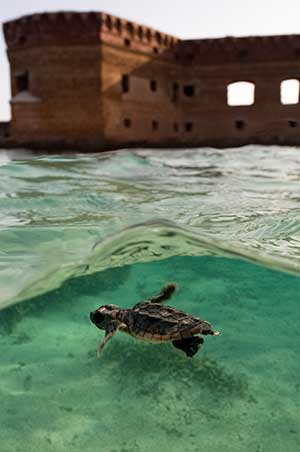 Dry Tortugas National Park is on the "bucket list" for many bird watchers. Due to its unique location along migratory routes and the pristine habitat, it is a bird watchers dream. Over 299 different species have been officially spotted there, and it is not uncommon to see 70 or more species in the spring in a single day.
Dry Tortugas National Park is on the "bucket list" for many bird watchers. Due to its unique location along migratory routes and the pristine habitat, it is a bird watchers dream. Over 299 different species have been officially spotted there, and it is not uncommon to see 70 or more species in the spring in a single day.
Bird activity is greatest from March through September. During this time 80,000 Noddy and Sooty Terns nest on the nearby island of Bush Key. The seven tiny islands of Dry Tortugas are a vital layover for migrating birds traveling between South America and the U.S. and Canada. Migratory birds peak in April and May.
 Some of the common and rare species you will encounter include: Roseate and Bridled Terns, Masked and Brown Boobies, Red-Necked Phalarope, Red-Footed Boobie, the Caribbean Short-Eared Owl, White-Tailed Tropicbird, Shiny Cowbird and the Golden Warbler.
Some of the common and rare species you will encounter include: Roseate and Bridled Terns, Masked and Brown Boobies, Red-Necked Phalarope, Red-Footed Boobie, the Caribbean Short-Eared Owl, White-Tailed Tropicbird, Shiny Cowbird and the Golden Warbler.
Throughout the year, look for Frigate Birds, Brown Pelicans, Double Crested Cormorants, Sandpipers and more.
Bring along your binoculars & scopes
 The Dry Tortugas are home to about 30 species of coral. Corals are marine organisms that typically live in colonies consisting of many individual soft-bodied organisms called polyps, each only a few millimeters in diameter. After a polyp attaches itself to a hard substrate on the sea floor, it divides itself into thousands of clones. The polyps cement themselves to each other by secreting a skeleton of calcium carbonate, thereby creating a colony that acts as a single organism. Over the course of hundreds to thousands of years, the colonies join together to form reefs.
The Dry Tortugas are home to about 30 species of coral. Corals are marine organisms that typically live in colonies consisting of many individual soft-bodied organisms called polyps, each only a few millimeters in diameter. After a polyp attaches itself to a hard substrate on the sea floor, it divides itself into thousands of clones. The polyps cement themselves to each other by secreting a skeleton of calcium carbonate, thereby creating a colony that acts as a single organism. Over the course of hundreds to thousands of years, the colonies join together to form reefs.
These slow growing coral reefs are a very fragile eco-system that can be easily damaged. When swimming and snorkeling take a look but don’t touch approach, only stand in white sand areas and for sun protection use ‘reef safe’ sunscreen or wear a rash guard.
Read about the Nature Conservancy Coral Restoration Project at Dry Tortugas
 When Spaniard Ponce De Leon discovered the Dry Tortugas in 1513, he named them Las Tortugas (The Turtles) due to the abundance of sea turtles.
When Spaniard Ponce De Leon discovered the Dry Tortugas in 1513, he named them Las Tortugas (The Turtles) due to the abundance of sea turtles.
For hundreds of years these turtles provided fresh meat for mariners, pirates, and peoples living in the Florida Keys. At one time turtling was a big business in Key West, with a cannery brewing popular green turtle soup that was shipped out to northern cities.
The five species of sea turtles found in the Dry Tortugas region are Green, Loggerhead, Kemp's Ridley, Hawksbill, and Leatherback. But years of hunting have taken their toll, and these once abundant turtles are now all on the Endangered Species List.
Today the Park is the most active turtle nesting site in Florida. Park Service biologists have been monitoring sea turtle nesting activity within park boundaries since 1980. They survey the park's seven islands daily throughout the nesting season and document the presence of turtle tracks or "crawl." When researchers find a specially-shaped mound of sand on the beach, they know it is a nest. Each nest is marked and recorded.
Forty-five days later the nest is checked for signs of hatchlings. Three days later, researchers evacuate the nest, release any trapped hatchlings, and record the number of eggs. Over 2,330 Loggerhead and Green turtle crawls have occurred during the last four seasons on only three miles of beach!
To protect the marine resources of the Dry Tortugas a 46 square-mile Research Natural Area (RNA) has been created. This is a no-take ecological preserve that provides a sanctuary for species affected by fishing and loss of habitat in this region of the Gulf.
For more information click here.